Silvertip Shark
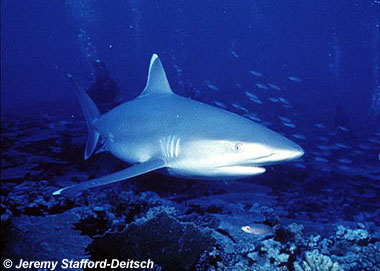
Carcharhinus albimarginatus
This streamline requiem shark tends to appear blue-gray from above, with a bronze sheen, paling to white below. The silvertip name comes from the white tips and borders on all of its fins. It averages between 6 and 8 feet long but can get to be almost 10 feet and over 300 pounds. This aggressive shark often dominates interactions with sharks that are larger than itself.
Order – Carcharhiniformes
Family – Carcharhinidae
Genus – Carcharhinus
Species – albimarginatus
Common Names
English language common names include silvertip shark, silver-tip shark, and white fin. Common names in other languages include aileron blanc du récif (French), aso (Samoan), bagea mara (Gela), cazon (Spanish), gursh (Arabic), iho (Surigaonon), ikan yu (Malay), jarjur (Arabic), kattafulhi miyaru (Maldivian), marracho de pontas (Portuguese), mwoashog (Carolinian), pating (Tagalog), requin pointe blanche (French), riff-weißspitzenhai (German), silwertiphaai (Afrikaans), te bakoa (Kiribati), tiburón de puntas blancas (Spanish), tsumajiro (Japanese), and zarlacz srebrnopletwy (Polish).
Importance to Humans
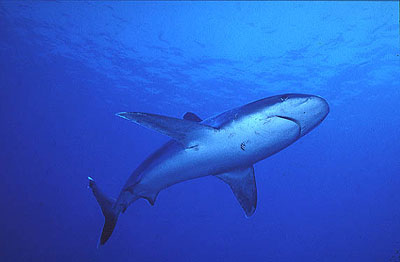
Data on the silvertip fisheries is lacking although it is probably taken throughout its range. The flesh can be utilized fresh or dried-salted for human consumption.
Danger to Humans
The silvertip shark should be treated with caution, as it is potentially dangerous to humans. It is considered potentially dangerous due to its large size, abundance around offshore reefs. According to the International Shark Attack File, this species has been responsible for one unprovoked attack. Although it tends to keep a distance from divers and swimmers, the silvertip shark will become excited and bold when bait is present.
Conservation
> Check the status of the silvertip shark at the IUCN website.
The IUCN is a global union of states, governmental agencies, and non-governmental organizations in a partnership that assesses the conservation status of species.
Geographical Distribution
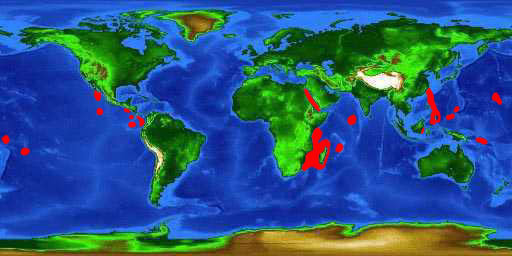
In the western Indian Ocean region, the silvertip is found in the Red Sea and off East Africa including Madagascar, Seychelles, Aldabra Group, Mauritius, and the Chagos Archipelago. Its range in the western Pacific Ocean is from off southern Japan to northern Australia and French Polynesia and in the eastern central Pacific from southern Baja, California, Mexico to Colombia including the Cocos, Galapagos, and Revillagigedo Islands.
Habitat
This shark is commonly found both inshore over continental and insular shelves as well as offshore over banks. It is often reef-associated and lives at depths to 2,625 feet (800 m). Young individuals reside in shallow waters close to shore to minimize risk from predation.
Biology
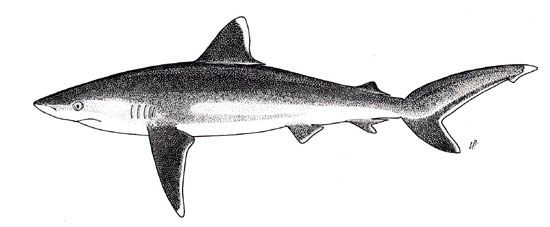
Distinctive Features
The silvertip shark is slender with a long and broadly rounded snout. The eyes are large and round. An interdorsal ridge is present on this species. The first dorsal fin is large with a pointed apex. It originates over or slightly in front of the free tips of the pectoral fins. The second dorsal fin originates over or just behind the origin of the anal fin. The pectoral fins are large and semifalcate with narrowly rounded or pointed tips. The caudal fin is asymmetrical in shape with a rather large upper lobe.
Coloration
The body is dark gray or gray-brown with a bronzy sheen, fading to a white ventral side. An inconspicuous white band is located on the flank region. This shark’s common name “silvertip shark” is in reference to the conspicuous white tips and trailing margins on all of its fins. The silvertip may be confused with grey reef sharks (Carcharhinus amblyrhynchos), however the grey reef shark has dark tips on the pectoral fins and trailing edge of the caudal fin. Also, the whitetip reef shark (Triaenodon obesus) is similar in appearance to the silvertip shark. Although both shark species have white markings on the dorsal and caudal fins, the whitetip reef shark lacks this marking on the tips of the pectoral fins. The whitetip reef shark also has a more square-shaped snout.
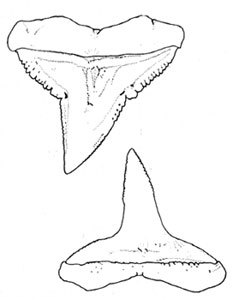
Dentition
Dentition of the silvertip shark consists of 12-14 teeth in each jaw. The upper teeth are broad and strongly serrated. The cusps are high and triangular and the crown feet have coarse serrations or low cusplets. The lower teeth have erect, broad serrated cusps with transverse roots.
Size, Age, and Growth
The silvertip shark grows to a maximum total length of 9.8 feet (3 m). However, the average length of this species is 6.6-8.2 feet (2-2.5 m). The maximum published weight of the silvertip shark is 358 pounds (162.2 kg). This species, both males and females, reaches maturity at lengths of 5.2-6.2 feet (1.6-1.9 m).
Food Habits
Prey of the silvertip shark includes benthic and midwater fishes such as wahoo, eagle rays, wrasses, and tunas as well as small sharks. This shark also feeds on octopuses and squid. The silvertip shark has been observed swimming along the edge of a group of other species of feeding sharks, dashing into the group to swipe some food.
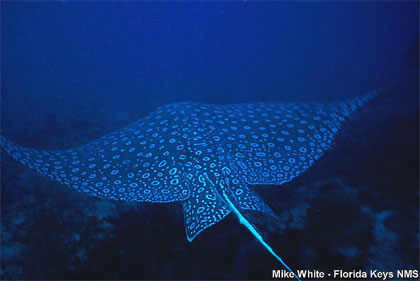
Reproduction
Mating behavior includes distinct pairing and occurs during the summer months in the southern hemisphere. This is followed by a yearlong gestation period with the young born in the summer. The mode of reproduction is viviparous which means the embryos are nourished through a yolksac placenta. Each litter consists of 1-11 pups with each measuring between 24.8 and 26.7 inches (63-68 cm) in length. The pups live among shallow reefs, feeding on small fishes. They eventually move out to deeper water as they increase in size.
Predators
Information regarding predators of the silvertip shark is limited. Large piscivorous fishes and other sharks are potential predators of juveniles.
Taxonomy
The silvertip shark was originally described as Carcharias albimarginatus by Rüppell, in 1837. This name was changed to the currently valid Carcharhinus albimarginatus (Rüppell) later that same year. The genus name Carcharhinus is derived from the Greek “karcharos” meaning sharpen and “rhinos” meaning nose. The species name albimarginatus is from the Latin “albi” meaning white and “marginatus” meaning to enclose with a border. Synonyms referring to this species in previous scientific literature include Eulamia platyrhynchus Gilbert 1892 and Carcharhinus platyrhynchus Gilbert 1892.
Prepared by: Cathleen Bester